| 1 | Peringuey’s adder |
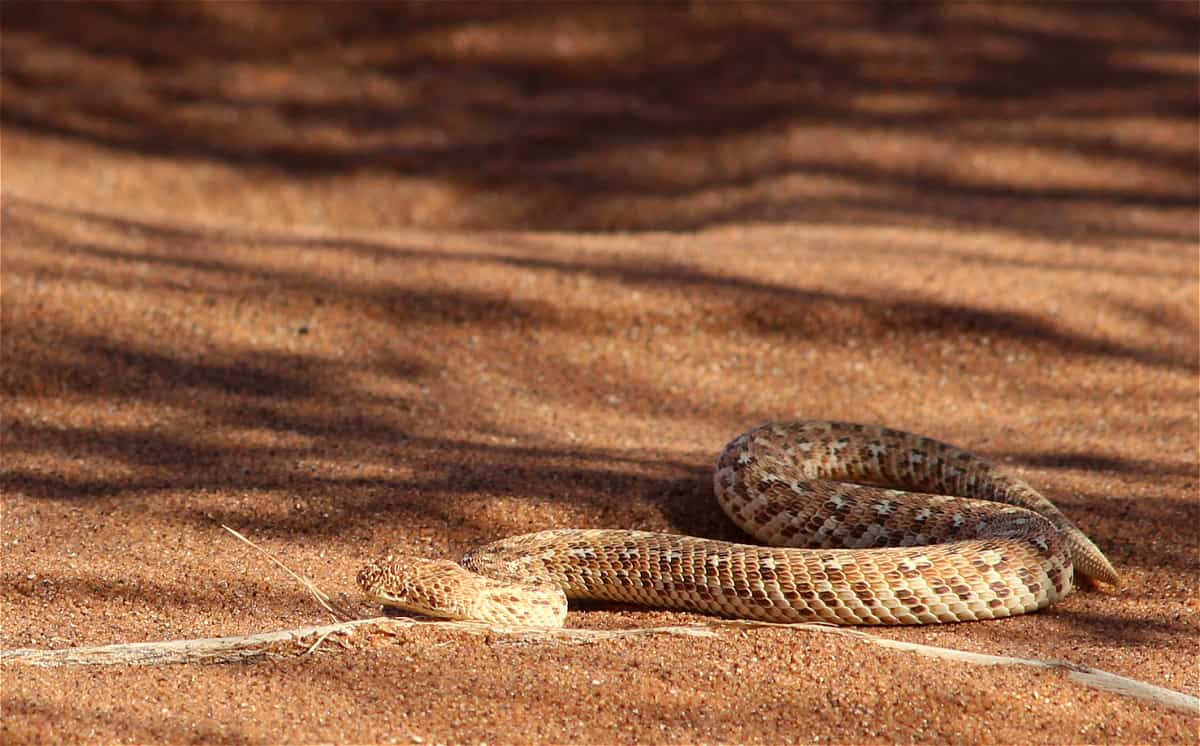
A venomous snake with a small empire, appearing only in Namibia and far southern Angola. Peringuey’s adder lives mainly in the parched Namib desert of Namibia’s south, and is one of the most desert-adapted snakes on Earth.
Like a sidewinder or Saharan horned viper, Peringuey’s adders are adapted to cope with the driest of all conditions, and can glide down rolling sand dunes with ease. This species is also dubbed the desert sidewinding adder, because sidewinding is one of their survival techniques, as it minimises contact with the searing desert sand. Their choice of food is limited to others that can cope with such harsh deserts, such as barking geckos and desert lizards (Meroles genus).
Though with cunning vertical pupils and an angry appearance, Peringuey’s adder is little threat to humans, even when you exclude their remoteness. Their venom is cytotoxic and causes pain and moderate swelling, but no deaths are confirmed. It’s also very easy to spot Peringuey’s adder, at least when they’re moving. Even with their sandy camouflage, you’d have to be blind to miss one sidewinding down a sand dune. They live mainly in wide open spaces, except for when they stray to dry scrubland.
The biggest risk with Peringuey’s adder is when they bury themselves up to the eyeballs in sand. Like the Saharan horned viper thousands of miles away, Peringuey’s adders do this to leap on prey unexpectedly, bursting from the desert floor in a shower of sand particles. This venomous snake is tiny, reaching a record of just 32cm. They also have one of the most triangular heads of any snake.
| 2 | Anchieta’s cobra |
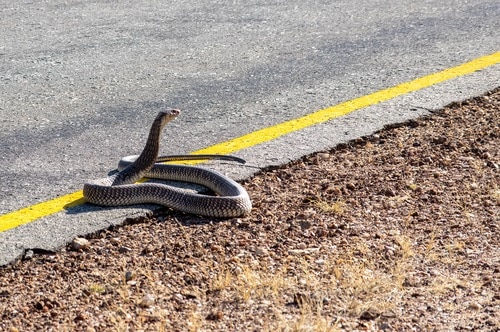
A moderately sized cobra, which reaches up to 231cm in males and 218cm in females (that we know of). This species avoids bone dry southern Namibia and sticks to the moister northern areas, crossing the border into Angola as well. Their territory is relatively small for a cobra, and few around the world have heard of them, except for a handful of scientists and learned museum curators. This suits Anchieta’s cobra just fine, as they’d much rather fly under the radar. They’d much rather slither through dry plains, searching for mammals, with the confident knowledge that nobody is aware of them.
Anchieta’s cobras are relatively light for a cobra, with beige and grey intermingling subtly. Lab analysis reveals a strongly neurotoxic venom, with a secondary dose of cardiotoxins. Deaths are rare, but a few are confirmed, and the local dangers include rotting skin and blistering.
One power Anchieta’s cobra doesn’t have is spitting – they can’t blind you temporarily with a sudden globule of venom to the eye. Like most cobras, Anchieta’s cobra isn’t fussy about its diet, and will swallow mammals, lizards and other snakes without worry. They’re most closely related to the snouted cobra (Naja annulifera), yet with an extra dose of aggression. Windhoek, Namibia was the site of the longest Anchieta’s cobra ever measured, a male measuring 2.31 metres.
| 3 | Southwestern shovel snout |
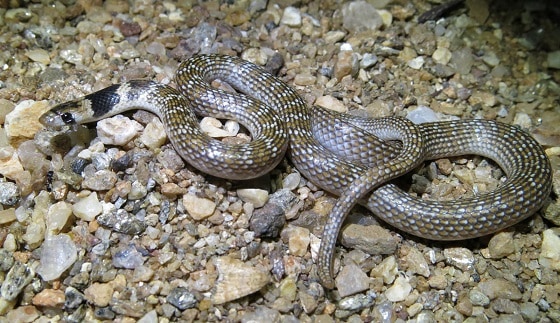
A harmless species averaging at 20-30cm, with a maximum of only 44cm. The southwestern shovel snout (Prosymna frontalis) is strictly a rock dweller. Grassy plains are out of bounds for them, as are sand dunes. They were first discovered in 1867, and are most commonly found after rainfall.
This species is a slow mover, yet a skilful climber. Prosnymna frontalis inhabits a great chunk of Namibia, and a small portion of South Africa over the southern border. Southwestern shovel snouts are completely harmless, both non-venomous and with a docile personality. Their diet is believed to consist mainly of reptile eggs.
The Prosymna genus of snakes has 18 members, all found in sub-Saharan Africa. This species is much less of a burrower than others members, preferring to hide in dark fissures between surface rocks instead. However, the namesake shovel snout is still partially in place, so they’re probably able to burrow if their lives depend on it.
People likely to meet this snake in Namibia include miners, rock collectors, bandits making a campfire, and archeologists embarking on a dig. This is a species you could watch all day if you sit still long and allow the snake to forget that you’re there.
| 4 | Bug-eyed house snake |
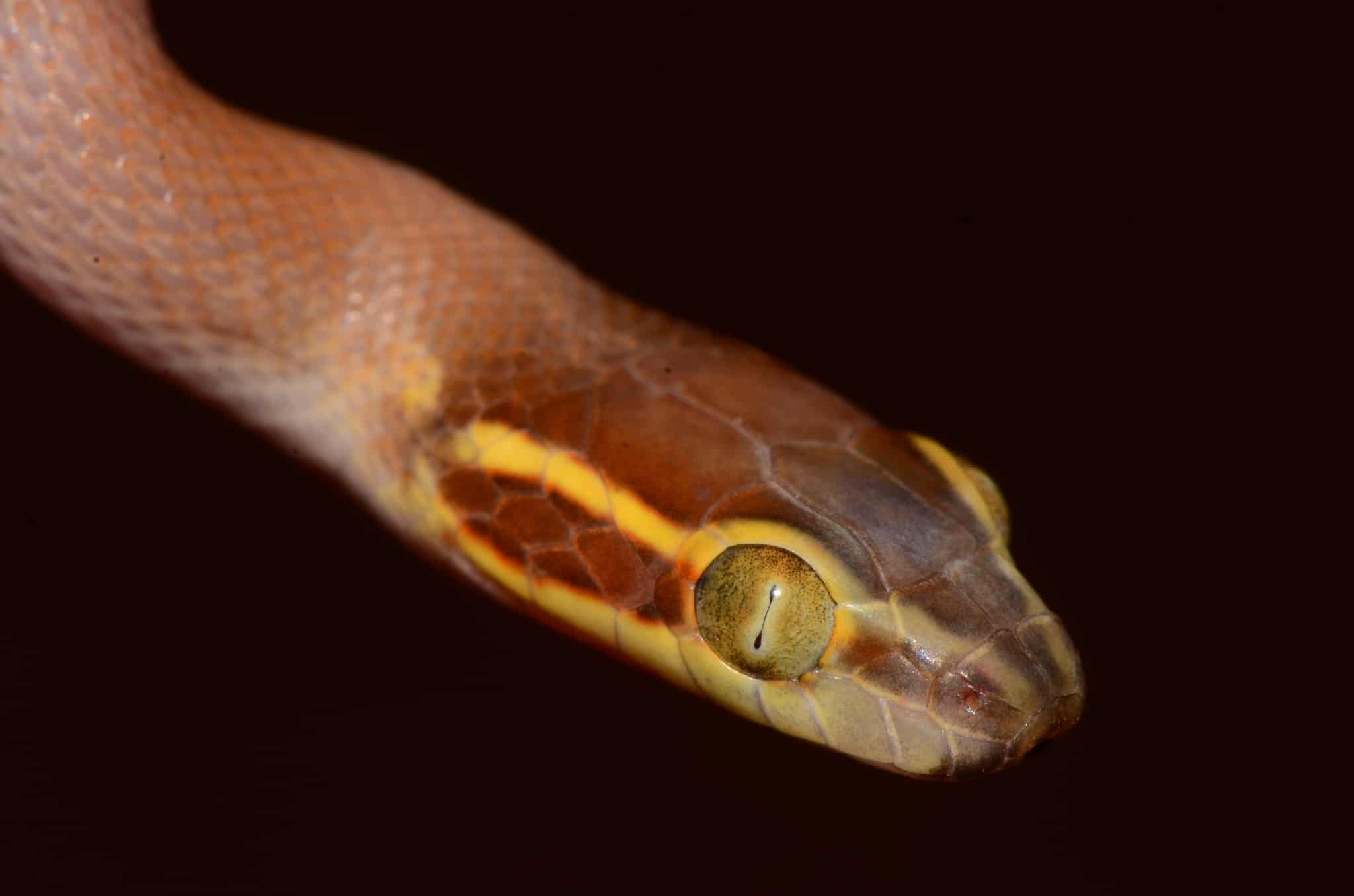
A snake known as Grootooghuisslang locally. Bug-eyed house snakes (Boaedon mentalis) inhabit northwest South Africa, but also have a stronghold in southern and western Namibia. This is a nocturnal snake, which has great patience and moves around the parched wilderness slowly and deliberately.
Bug-eyed house snakes are one of the easiest Namibian species to identify. There’s a simple characteristic to remember: two banana yellow lines behind each eye, and encircling the top and bottom. As adults, these colours fade in intensity, but are still visible. Away from the head, bug-eyed house snakes have virtually no patterns and are a consistent parched clay colour.
Though with sharply vertical pupils, the bug-eyed house snake looks far less menacing than a viper. This is borne out by reality, as Boaedon mentalis is a constrictor which lacks any venom whatsoever. Their diet is unresearched, but believed to consist of lizards and geckos with some rodents.
If the bug-eyed house snake duelled a cobra or black mamba, it would lose without question. However, they have a powerful squeeze force for their size, which is up to 60cm. Their eyes are a golden colour, while their forked tongue is a fleshy pink.
| 5 | Anchieta’s dwarf python |

The true python genus (Latin name: Python) has 10 members worldwide, and Anchieta’s python is the most obscure. The African rock python got a size headstart long ago, so instead, Anchieta’s python went down the route of camouflage.
This species lives in relatively moist northern Namibia, and crosses the border into Angola. They’re most common in rocky areas within savannahs, and hence, they’ve evolved a dirty brown base of scales overlaid with beige-black blotches, allowing them to blend in perfectly.
Anchieta’s python is often spotted in caves, and occasionally climbing trees within dry savannah. They can stay still for many days, as they wait for the cards of nature to fall in their favour. Unlike the rock python’s 6 metres, this species maxes out at just 183cm. Anchieta’s python are no threat to humans, but give intimidation a good go, with a piercing hiss.
Anchieta’s pythons generally eat warm-blooded prey such as rodents, and their closest relative worldwide is the ball python. However, Anchieta’s pythons are far less common in captivity. They’re rarer to begin with, and minefields planted in the Angolan civil war mean that swathes of habitat are too dangerous even for hardened soldiers to venture into, let alone amateur reptile collectors. If you wanted to track down an Anchieta’s cobra, then Namibia would be the smarter place.
| 6 | Karoo sand snake |
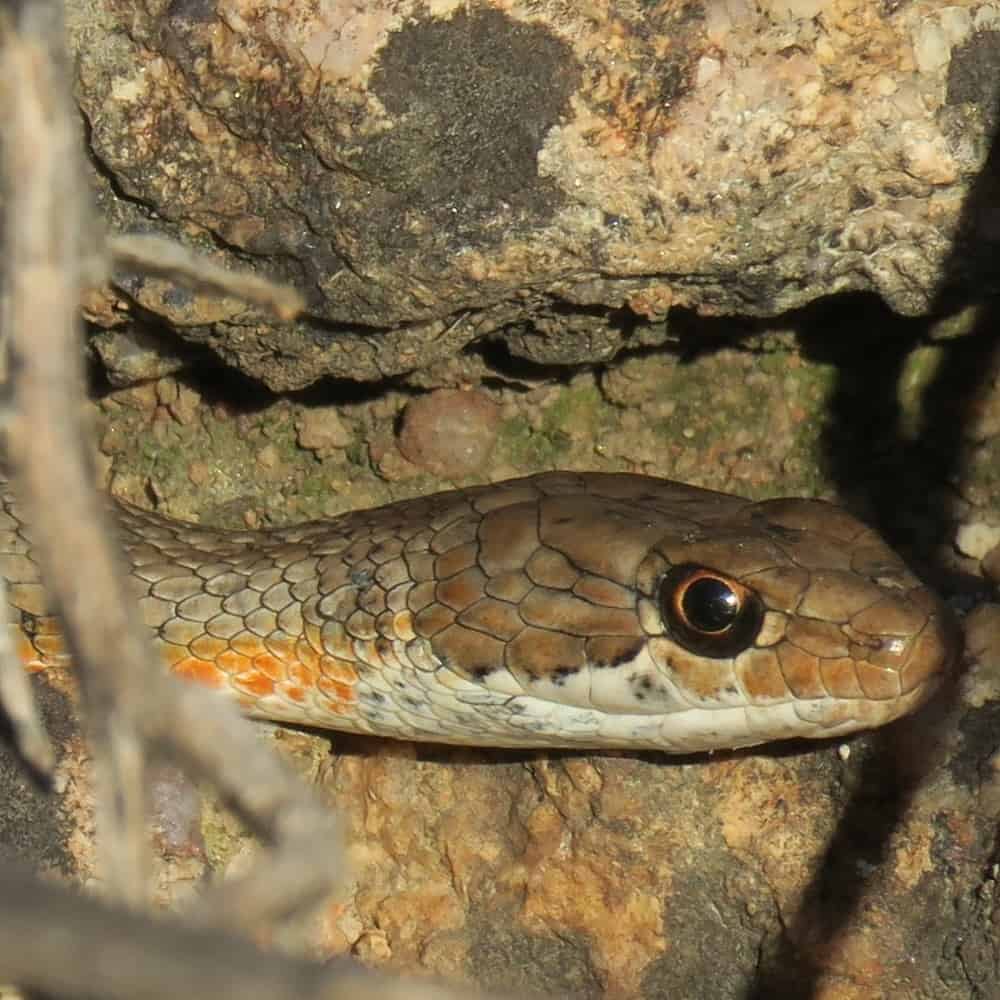
One of the 33-strong Psammophis genus, collectively called the sand racers. These snakes are extremely fast and whippy, and the Karoo sand snake is no exception. They occupy the entire eastern half of Namibia, and the western half of South Africa, showing no interest in trivial borders drawn up by mankind.
Karoo sand snakes (Psammophis notostictus) live not in sand deserts, but relatively parched areas covered with dry bushes. They’re a day-faring snake which reaches a maximum of 100cm, and are most commonly spotted by people crossing roads.
The Karoo sand snake has a long, flexible tail. As they dart between bushes at high speeds, they’re always swishing it through the air, using it to gain superior balance. In fact, they sometimes swish their tail right off. This species is confirmed to detach its tail at opportune moments, chiefly when in the clutches of a bird predator.
The tail distracts the bird, and the Karoo sand snake vanishes into the thorny depths of its favourite bush. It’s a painful, yet effective last ditch survival technique. Not all Psammophis members are confirmed to detach their tails – the hissing sand snake (Psammophis sibilans) of Ethiopia is another which has the power.
| 7 | Dwarf beaked snake |
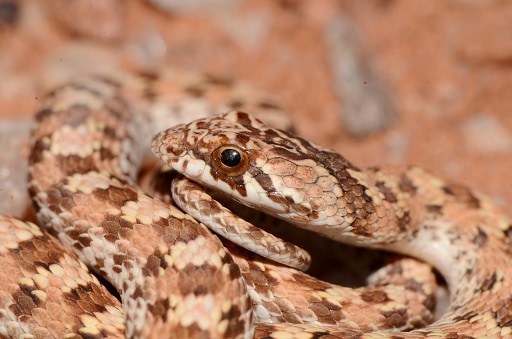
The dwarf beaked snake (Dipsina multimaculata) is another mostly harmless species of Namibia, with a mild venom designed for subduing lizards, its main prey. This species is found in most of Namibia, plus northwest South Africa, and extreme southwest Botswana. Their main heartland is the Namib desert, where they don’t appear on actual sand dunes, but are plentiful in karoo scrub, arid savannah, and gravel plains, where their lizard prey is also common.
Dwarf beaked snakes are believed to be a visual mimic of their dangerous neighbour, the horned viper (Bitis caudalis). They have a beige underlying colour, overlaid with brownish markings, and this doubles up as a perfect camouflage in their parched habitats. A bird flying overhead would struggle to spot this snake, as would a group of conservationists flying over the Namib desert in a helicopter. They’d have to get incredibly lucky and train their binoculars on precisely the correct 5 metre parcel of land, and even then, they’d have difficulty distinguishing it from a low thorny scrub.
The dwarf beaked snake reaches a maximum of just 50cm. Up close, their eyes look like a distant unlit planet: a round black pupil and a red iris, with a small white line around the pupil.
| 8 | Angolan coral snake |
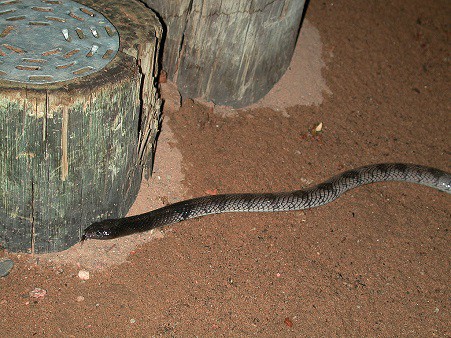
A heavily nocturnal snake which is most commonly seen crossing roads, aided by a car’s headlights. The Angolan coral snake (Aspidelaps lubricus) is found in Namibia and western South Africa, with a small area of land in southern Angola. Its venom is poorly researched, yet is confirmed to be neurotoxic and has caused several deaths. This species has an especially painful bite, and unlike a black mamba, no antivenom exists yet.
Angolan coral snakes reach a maximum of 76cm, and have highly variable colours. Some individuals are black against pale grey, and darken towards the head, which is fully black. Others have pale chest bands which are clearly mimicking a cobra, while others are significantly redder. Angolan coral snakes even rear up and flare their necks to complete the cobra mimicry.
This is a species of dry, rocky landscapes well away from settlements – hence why Namibia is their base. Angolan coral snakes are venomous, and a severe danger to mankind if you’re lucky enough to step on one, or park your car on a desert highway at night and rest directly next to where they live.
Their strike is also similar to a cobra, with a piercing hiss and repeated savage lunges. Angolan coral snakes are much more aggressive than coral snakes of the Americas. You should watch this Namibian snake from a distance only.
| 9 | Karoo tiger snake |
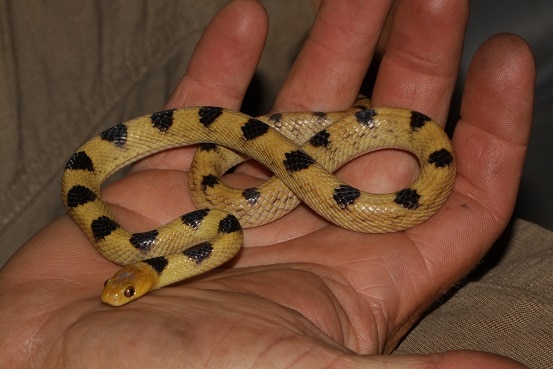
A close relative of the eastern tiger snake which roams South Africa (neither are related to Australia’s tiger snakes). This is a mostly harmless species, with round eyes and only two sharply contrasting colours. Karoo tiger snakes measure 40-60cm (maximum 68cm) and are restricted to the southern half of Namibia, where they inhabit rocky arid regions. Their diet consists mainly of lizards and geckos.
Karoo tiger snakes (Telescopus beetzi) are common where they live, and as usual in these sparsely populated parts, are mainly sighted when crossing roads. Like most snakes, their eyesight isn’t great, but a few metres away, they’ll sense your presence and start hissing aggressively, while drawing their head back and hanging their mouth open. If they do land a rare bite, then you have absolutely nothing to fear.
Karoo tiger snakes are a fully separate species from their South African cousin, even though their rich yellow and black shades are virtually identical. The difference is in the size of the blotches. In Karoo sand snakes, they’re rounded and fuller, whereas in eastern tiger snakes, they’re sometimes so thin that they become stripes.
Exactly why this evolved is a mystery. There may be no reason – the Karoo desert colony may have headed north 1 million years ago, and any two species which are separated for long periods will naturally develop differences, even if there’s no motivation.
| 10 | Schinz’s beaked blind snake |
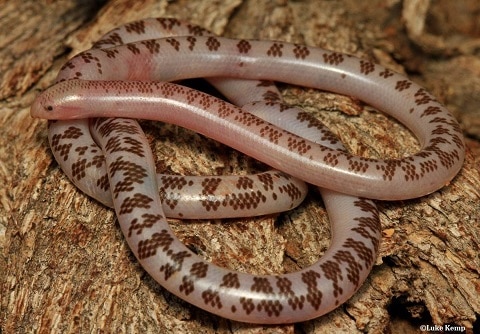
This tiny blind snake inhabits 4 countries: western South Africa, southwest Botswana, far southern Angola, and a huge swathe of Namibia. There are dozens of blind snakes worldwide, humble soil lovers which mainly live underground and have very poor eyesight. However, this Namibian species has a difference, something no human could dream of – a beak.
Shinz’s beaked blind snake (Rhinotyphlops schinzi) reaches a record of only 29cm, and lacks any venom. They’re mainly found in arid regions of southern Namibia, and spend most of their lives below the surface. However, they venture to the surface occasionally, where locals often encounter them on roads. When caught, they never bite, but wriggle furiously in the palm of your hand.
This snake has incredibly smooth scales, giving them the appearance of nakedness like an earthworm. The purpose of this smoothness is gliding effortlessly through underground soil tunnels without dirt sticking to them. A black mamba would be coughing and spluttering constantly if it ventured to the same places as Rhinotyphlops schinzi.
Schinz’s beaked blind snakes feed mainly on ants and ant pupae. The exact reason for its namesake beak is a mystery, but we have an educated guess: that the downward pointing beak is for scraping loose dirt away and uncovering its tiny insect prey.
